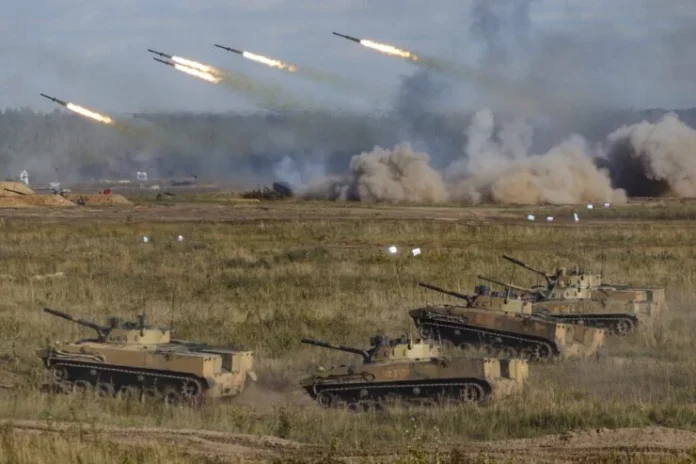Top officials from around 40 countries held talks in Jeddah last weekend to discuss the ongoing Russia-Ukraine conflict. Attendees included diplomats from the US and European Union, besides China and India. Russia, for obvious reasons, was not a participant. The Ukrainian President, Volodymyr Zelenskyy, said he wanted the talks to culminate in a peace summit this autumn.
India’s National Security Adviser Ajit Doval reiterated India’s position on the Ukraine conflict, saying his country’s approach “has been, and always will be, to promote dialogue and diplomacy”. This was the only way forward for peace, Doval said, adding that India would help in finding a lasting, comprehensive solution to the Russia-Ukraine conflict.
The state-run Tass news agency of Russia reported a cryptic comment by Kremlin spokesperson Dmitri Peskov: “Russia will keep an eye on this meeting” but would need “to fully understand what goals are being set”.
Impact on Global Food Prices
The war in Ukraine, in conjunction with the West’s sanctions imposed against Russia, have led to a huge decline in the supply of major staple foods; and the extensive environmental damage, or ‘ecocide’, caused by the war has led to food crises worldwide, resulting in a spike in food prices globally. The emerging and developing economies are the hardest-hit as they rely heavily on the region for their food and energy needs—viz. grain and fuel imports.
Ukraine accounts for the world’s largest production of sunflower oil. In tandem with Russia, it is responsible for over half the world’s vegetable oils exports. This ‘grain basket’ also exports more than a third of the world’s wheat requirements.
Russian Invasion Background
Before the invasion, as Russian troops amassed at Ukraine’s borders, Russia denied any plans to attack. President Vladimir Putin announced a ‘special military operation’ to support the breakaway republics of Donetsk and Luhansk, whose military forces were fighting Ukraine in the Donbas conflict. Putin claimed the goal was to ‘demilitarize’ and ‘deNazify’ Ukraine.
Putin spread the falsehood that Ukraine was governed by neo-Nazis persecuting the ethnic Russian minority. Russia launched simultaneous air strikes and a ground attack at a northern front extending from Belarus towards Ukrainian capital Kyiv; at a northeastern front towards Kharkiv; at a southern front from Crimea; and a southeastern front from the Donbas. Ukraine enacted martial law and ordered a general mobilization. The occupation had started in 2014 following Russia’s invasion and annexation of the Crimean peninsula, and assisting the forces of the mostly unrecognized Donetsk and Luhansk People’s Republics in capturing strategic areas of the Donetsk and Luhansk oblasts during the Donbas war.
Full Scale Invasion – February 2022
On February 24, 2022, Russian forces launched a full-scale invasion of Ukraine and occupied larger areas throughout the country, escalating by several notches the Russo-Ukrainian War which began in 2014. Before 2022, Russia had occupied 42,000 sq.km of Ukraine’s territory (Crimea and parts of Donetsk and Luhansk). After its full-scale invasion, by March 2022, it occupied an additional 119,000 sq.km—a total of 161,000 sq.km or close to 27 per cent of the Ukrainian territory.
However, due to stiff and unrelenting Ukrainian resistance, coupled with ground logistical challenges, the Russian armed forces announced their withdrawal from Chernihiv, Kyiv, Sumy and Zhytomyr oblasts in early-April. Tens of thousands of people have been killed on both sides. The Russian forces have perpetrated horrific, mass civilian casualties and been accused of torturing captured Ukrainian soldiers. By June 2022, about 8 million Ukrainians had been internally displaced and over 8.2 million had fled the country by May 2023. This was, by any measure, Europe’s worst refugee crisis since World War II.
In early-September 2022, the Ukrainian forces launched a successful counter-offensive in the Kharkiv region, inflicting a major defeat on the Russian forces and forced them to retreat. Later in the year, the Ukrainian forces once again achieved a major success with a southern counter-offensive retaking the city of Kherson on November 11.
On September 30, 2022, Russia announced the annexation of Donetsk, Kherson, Luhansk and Zaporizhzhia oblasts, despite only occupying part of the claimed territory. The UN General Assembly passed a resolution rejecting the annexation of these territories as ‘illegal’ and upholding Ukraine’s right to territorial sovereignty.
The Battlefield Scenario Now
Both sides are now facing off in bitter strife as Moscow’s ‘special military operation’ that was supposed to take only a few days, grinds into another ‘no-win’ year. Ukraine’s forces are confronting Russian defence fortifications digging in their heels along a 966-kilometre-long battlefront—in some areas up to 31 kilometres deep—that were built in the winter of 2022 even as Ukraine awaited supply of heavy artillery from its allies before it launched its June counter-offensive. These fortifications comprise networks of mines, trenches, bunkers and swathes of anti-tank obstacles.
And Ukraine’s earlier counter-offensives that seemed to have reaped huge dividends appear unlikely to favour Ukraine this time around. Indeed, since the June counter-offensive was launched, Ukraine has been able to capture only a few villages. Although the Ukraine Defense Ministry claims large gains near Bakhmut, in Donetsk in the east, and also in the south, its troops face an insurmountable challenge trying to break through the Russian cordons and advance southwards to the port cities of Berdyansk and Melitopol on the Azov Sea.
Meanwhile, Russia is drafting in mercenaries and young-blooded recruits into close combat on the peripheries of such towns as Vuhledar and Bakhmut. On the other hand, Ukraine’s NATO allies and partner countries have delivered more than 98 per cent of the combat vehicles promised to Ukraine, providing Kyiv with bigger firepower for its counter-offensive. Ukraine’s Western allies have sent over 1,550 armoured vehicles, 230 tanks and other pieces of equipment and provided ‘vast amounts of ammunition’, besides training more than nine nouveau Ukrainian brigades.
US President Joe Biden went on record in Poland just a day after an unannounced visit to Kyiv in April, saying “Ukraine will never be a victory for Russia. Never…”
Every conflict happens with its own sets of challenges and unique logistical complications. But an out-and-out victory for either of the sides in this war is an unrealistic expectation, say experts. A long-drawn conflict—perhaps stretching into years, or even decades, leaving both sides battle-scarred, bloodied and exhausted, but with indomitable spirit that refuses to accept defeat—seems a more likely future scenario. Eventually, a frozen conflict or a tense armistice may put a temporary halt to the current hostilities.
–The author of this article is a Defence, Aerospace & Political analyst based in Bengaluru. The views expressed are of the author and do not necessarily reflect the views of Raksha Anirveda
-The author is a Defence, Aerospace & Political Analyst based in Bengaluru. He is also Director of ADD Engineering Components, India, Pvt. Ltd, a subsidiary of ADD Engineering GmbH, Germany. You can reach him at: girishlinganna@gmail.com. The views expressed are personal and do not necessarily carry the views of Raksha Anirveda






